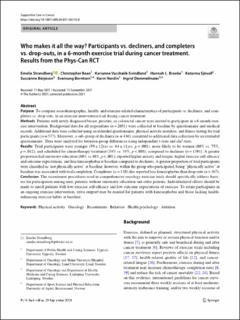| dc.contributor.author | Strandberg, Emelie | |
| dc.contributor.author | Bean, Christopher | |
| dc.contributor.author | Vassbakk-Svindland, Karianne | |
| dc.contributor.author | Brooke, Hannah L. | |
| dc.contributor.author | Sjövall, Katarina | |
| dc.contributor.author | Börjeson, Sussanne | |
| dc.contributor.author | Berntsen, Sveinung | |
| dc.contributor.author | Nordin, Karin | |
| dc.contributor.author | Demmelmaier, Ingrid | |
| dc.date.accessioned | 2022-01-04T10:43:16Z | |
| dc.date.available | 2022-01-04T10:43:16Z | |
| dc.date.created | 2021-10-13T14:58:38Z | |
| dc.date.issued | 2021 | |
| dc.identifier.citation | Strandberg, E., Bean, C., Vassbakk-Svindland, K, . Brooke, H.L., Sjövall, K., Börjeson, S., Berntsen, S., Nordin, K. & Demmelmaier, I. (2021) Who makes it all the way? Participants vs. decliners, and completers vs. drop-outs, in a 6-month exercise trial during cancer treatment. Results from the Phys-Can RCT Supportive Care in Cancer. 2021, . | en_US |
| dc.identifier.issn | 0941-4355 | |
| dc.identifier.uri | https://hdl.handle.net/11250/2835958 | |
| dc.description.abstract | Purpose To compare sociodemographic, health- and exercise-related characteristics of participants vs. decliners, and completers vs. drop-outs, in an exercise intervention trial during cancer treatment.
Methods Patients with newly diagnosed breast, prostate, or colorectal cancer were invited to participate in a 6-month exercise intervention. Background data for all respondents (n=2051) were collected at baseline by questionnaire and medical
records. Additional data were collected using an extended questionnaire, physical activity monitors, and ftness testing for trial
participants (n=577). Moreover, a sub-group of decliners (n = 436) consented to additional data collection by an extended
questionnaire . Data were analyzed for between-group diferences using independent t-tests and chi2
-tests.
Results Trial participants were younger (59±12yrs vs. 64±11yrs, p<.001), more likely to be women (80% vs. 75%,
p=.012), and scheduled for chemotherapy treatment (54% vs. 34%, p<.001), compared to decliners (n=1391). A greater
proportion had university education (60% vs 40%, p<.001), reported higher anxiety and fatigue, higher exercise self-efcacy
and outcome expectations, and less kinesiophobia at baseline compared to decliners. A greater proportion of trial participants
were classifed as ‘not physically active’ at baseline; however, within the group who participated, being “physically active” at
baseline was associated with trial completion. Completers (n=410) also reported less kinesiophobia than drop-outs (n=167).
Conclusion The recruitment procedures used in comprehensive oncology exercise trials should specifcally address barriers for participation among men, patients without university education and older patients. Individualized eforts should be
made to enroll patients with low exercise self-efcacy and low outcome expectations of exercise. To retain participants in
an ongoing exercise intervention, extra support may be needed for patients with kinesiophobia and those lacking healthenhancing exercise habits at baseline. | en_US |
| dc.language.iso | eng | en_US |
| dc.publisher | Springer | en_US |
| dc.rights | Navngivelse 4.0 Internasjonal | * |
| dc.rights.uri | http://creativecommons.org/licenses/by/4.0/deed.no | * |
| dc.title | Who makes it all the way? Participants vs. decliners, and completers vs. drop-outs, in a 6-month exercise trial during cancer treatment. Results from the Phys-Can RCT | en_US |
| dc.type | Journal article | en_US |
| dc.type | Peer reviewed | en_US |
| dc.description.version | publishedVersion | en_US |
| dc.rights.holder | © The Author(s) | en_US |
| dc.subject.nsi | VDP::Medical disciplines: 700::Clinical medical disciplines: 750 | en_US |
| dc.source.pagenumber | 1739-1748 | en_US |
| dc.source.journal | Supportive Care in Cancer | en_US |
| dc.identifier.doi | 10.1007/s00520-021-06576-0 | |
| dc.identifier.cristin | 1945636 | |
| cristin.ispublished | true | |
| cristin.fulltext | original | |
| cristin.qualitycode | 1 | |

